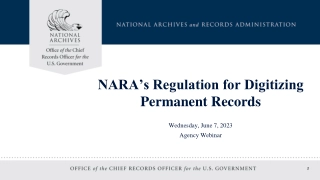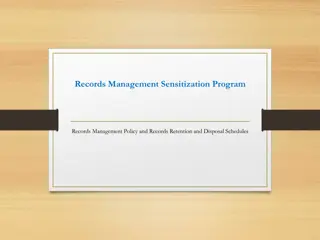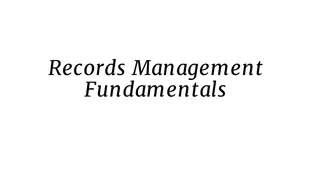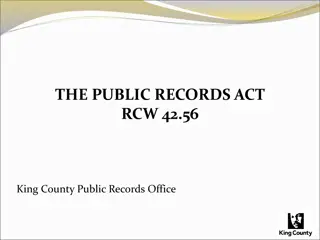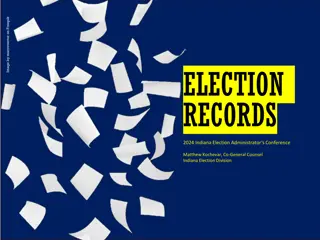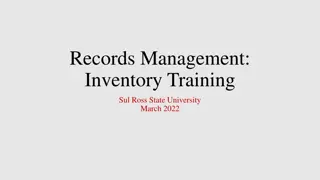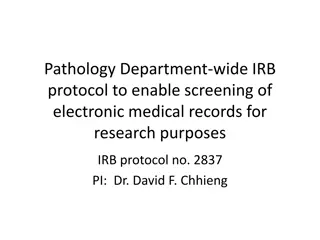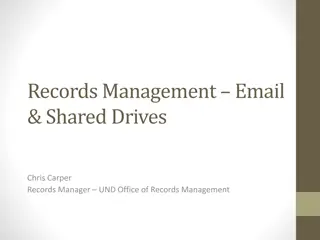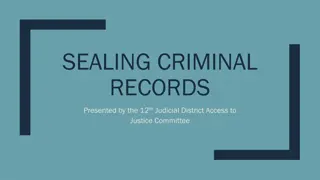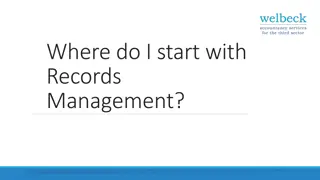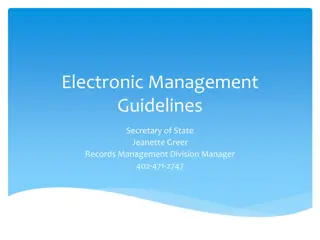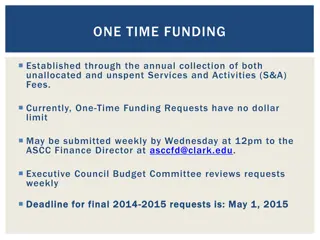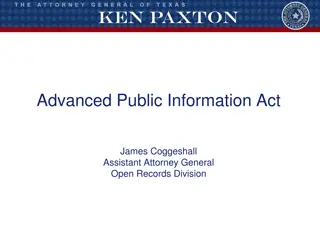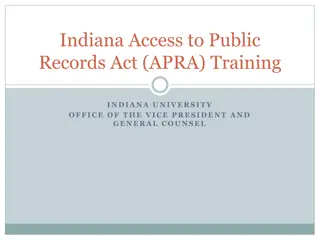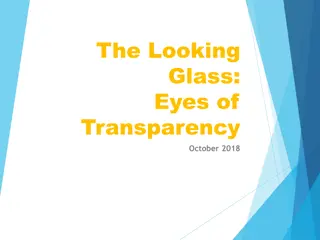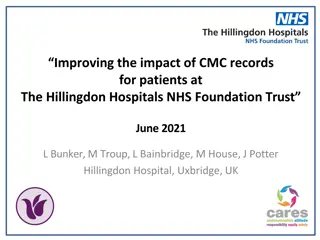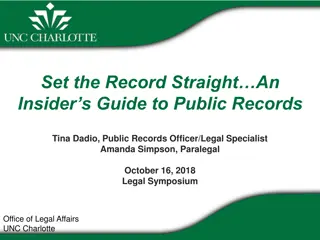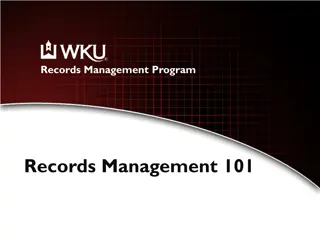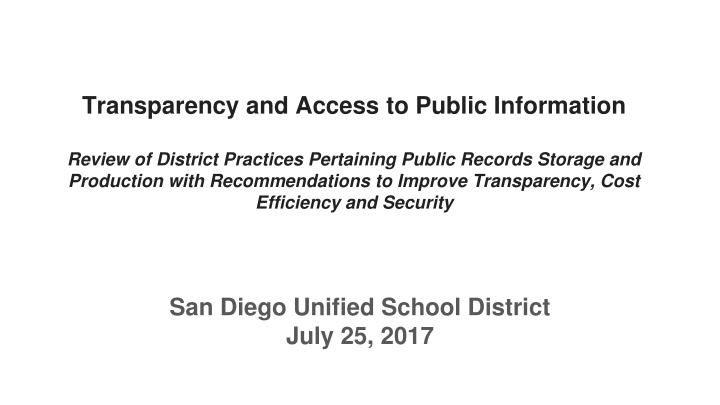
Improving Transparency and Access to Public Information in San Diego Unified School District
Explore the review of district practices on public records storage and production to enhance transparency, cost efficiency, and security in San Diego Unified School District. Learn about accessing district information, maintenance of records, legal requirements, and storage of electronic records.
Download Presentation

Please find below an Image/Link to download the presentation.
The content on the website is provided AS IS for your information and personal use only. It may not be sold, licensed, or shared on other websites without obtaining consent from the author. If you encounter any issues during the download, it is possible that the publisher has removed the file from their server.
You are allowed to download the files provided on this website for personal or commercial use, subject to the condition that they are used lawfully. All files are the property of their respective owners.
The content on the website is provided AS IS for your information and personal use only. It may not be sold, licensed, or shared on other websites without obtaining consent from the author.
E N D
Presentation Transcript
Transparency and Access to Public Information Review of District Practices Pertaining Public Records Storage and Production with Recommendations to Improve Transparency, Cost Efficiency and Security San Diego Unified School District July 25, 2017
Where to Locate District Information 1.District website: www.sandi.net 2.Board meetings, Advisory Committee meetings, LCAP Workshops and Cluster meetings 3.Bargaining Unit Requests: Bargaining Units may submit a Request for Information ( RFI ) to the Labor Relations Department 4.Personnel Records: Employees may obtain their own personnel records from Human Resources 5.Transcripts: Transcripts are maintained at the last school of attendance for a student, and can be obtained directly from the site. During the summer, Quality Assurance will assist in obtaining site records. 2
Maintenance of District Records The Board of Education recognizes the importance of securing and retaining district documents. The Superintendent or designee shall ensure that district records are developed, maintained and disposed of in accordance with the law, Board policy and administrative regulations. (excerpted from proposed CSBA Board Policy 3580) 3
Legal Requirements for Retention of District Records California law classifies district records as follows: Class 1 - Permanent Records (must be kept) Annual Reports, Official Actions, Personnel Records, Student Records, Property Records Class 2 - Optional Records (may be kept) Any record considered temporarily worth keeping; all prior year records that are not Class 1 Class 3 - Disposable Records Any record that is not Class 1 or 2; must be destroyed during third school year after the year in which it originated These requirements are recited in current District administrative procedures and proposed Administrative Regulation 3580. 4
Storage of Electronic Records The California School Boards Association (CSBA) recommends: All district-related electronically stored information generated or received by a district employee shall be saved to an electronic file on the district s computer and retained for at least 180 days, or shall be printed by the employee and physically filed in a way that it can be easily retrieved when needed. It is recommended that the Board adopt proposed Administrative Regulation 3580 that includes an electronic records retention period of one year. 5
Best Practices for the Storage of Records Proposed BP 3580 requires the Superintendent to develop a secure document management system that provides for the storage, retrieval, archiving, storage and destruction of district documents, including electronic information. Currently, electronic records are stored locally in the District s data center, in the cloud, and at an off-site tape backup facility for disaster recovery depending on the application and record type. Many employees maintain records within their email accounts; however, email is not a secure means of transmitting and storing information. The District is an almost daily target of hacking attempts. 6
Non-Records According to the California Department of General Services, the following are defined as non-records to be discarded once they lose usefulness to staff: Letters of transmittal and acknowledgements of receipt which do not add any information to the material transmitted. Requests for printing services, after the request has been filled to the customer s satisfaction. Informal notes, worksheets, and rough drafts of letters, memoranda, or reports that do not represent the basic steps involved in the preparation of the communication. Notes, including stenographic notebooks and stenotype tapes, and dictating media which have been transcribed. Miscellaneous notices of community affairs, employee meetings, holidays. 7
Non-Records LAUSD defines the following as non-records not subject to the District retention requirements. Convenience copies of official Records, including printouts of Electronic Records Personal notes and personal correspondence, including personal email correspondence, even if on District premises or on a District-assigned computer Personal financial or tax information or any other information of a purely personal nature, even if on District premises or on a District-assigned computer Advertisements, spam or junk email received by District employees Preliminary drafts and informal notes that have no further value to the District* Library books, magazines, and pamphlets not prepared by or for the District Textbooks, maps used for instruction, and other instructional material Any other document (paper or electronic, including emails) that has nothing whatsoever to do with the District s business or with its students, teachers, other employees, or contractors. 8
Public Access to District Records The Board of Education recognizes the right of citizens to have access to public records of the District. The Board intends the district to provide any person reasonable access to the public records of the schools and district during normal business hours and within the requirements of law. Public access shall not be given to records listed as exempt from public disclosure under the California Public Records Act and other state and federal law. (Excerpted from proposed Board Policy BP 1340) 9
The California Public Records Act Under the California Public Records Act, the District is required to make all public records not exempt from disclosure available for public review and inspection. A public record is defined as: Any writing Containing information relating to the conduct of public business Prepared, owned, used or retained by the public agency Writings include handwritten and typewritten documents, electronically stored information, emails, text messages, etc. 10
Public Records Requests 1.Requests for Public Records are submitted to the Legal Services Office. 2.Upon receipt of the request, a search is initiated to determine whether the District has any records responsive to the request. 3.Within 10 days of receiving the request, a response is provided which states whether the District has any records responsive to the request, whether the District believes any or all of the records are exempt from disclosure, and when the District believes they will be ready for review. The 10-day period may be extended by an additional 14 days in unusual circumstances. 4.If the requester wants copies of physical documents or creation/reproduction of electronic records, a deposit is requested to cover the cost. 11
Timeline for Production of Records Under the Public Records Act, the District has a reasonable time after its response to produce responsive records. What constitutes a reasonable time depends on a number of factors, including: The number of requests the District receives. The scope and complexity of the requests; individually and collectively. The time required to collect records from multiple locations/departments. The number of responsive documents collected in response to each request. The time needed for legal review. 12
Process for Review and Production of Records 1.Legal Services staff contacts involved departments/personnel to request records. Where electronic communications (emails) are requested, IT is asked to conduct a search on our central servers for all responsive emails. 2.Where electronic records are requested, staff must create or extract the requested information. 3.All records are reviewed by Legal Services staff to determine whether they are responsive and whether they are subject to disclosure. The PRA contains many exclusions, including records subject to confidentiality and privilege. When possible, records are redacted rather than being withheld. 4.Responses are provided in the order the requests were received. 13
What Impacts the Length of Time Taken to Produce Records? The volume of requests received. The complexity of the requests The volume of records identified in response to a request, which must be reviewed by Legal staff prior to release. In particular, requests for emails, which often generate thousands of responsive records.* Staff time to format or create records requested in electronic form. *The District currently has 576 million emails on its servers, the majority of which do not constitute public records as defined in the Public Records Act! 14
Volume of Records Requests The volume of records requests continues to increase every year. The number of requests received in the past two years is shown below: FY 2015-16 FY 2016-17 273 321 The quality of the District s review process has been improved by assigning this work to more sophisticated staff members; however, the District has not added any staff to the review team. Currently, one person handles all incoming PRA requests and responses other than routine responses which can be handled directly by Facilities Planning Construction (FPC) staff. 15
Complex Requests Which Have Caused Delay The District often receives requests for electronic communications to/from multiple individuals with multiple search terms. As an example, a single search in response to a request for email communications initially caused the District s system to crash twice, once with a return 131,971 emails before it went down. That request was later modified into three separate requests. The combined result of these three requests generated 6,125 pages of responsive emails which had to be reviewed by Legal Services and redacted as needed before they could be produced. 16
PRA Process Used as a Litigation Strategy Additionally, the District often receives one or more requests for records from individuals or their attorneys seeking information relevant to threatened or ongoing litigation. As an example, in one case, the District received a request for documents in 25 categories. The search for these records crashed the system. In another example, the District received 23 separate requests on a single topic. A search in response to just one generated more than 4,000 emails which had to be reviewed by Legal staff prior to production. 17
Recommendations to Improve Efficiency 1.Post responses to records requests so that the public can search through them before making a request that duplicates a previous request. This is currently in place via BoardDocs. Records are posted in the BoardDocs Library. 2.Increase the amount of information posted on the District s website. The PRA allows us to direct requesters to the website if responsive records are available there. This work is ongoing. 3.Cull the amount of emails retained on District central servers which do not constitute public records to reduce the volume of emails which must be reviewed. 18
Email Retention - Current status Currently: 60,000,000 - Average Number of Emails Received Per Year 576,000,000* - Emails Stored in Users Inboxes 40,800,000* - Megabytes of Data Storage 19
Email Storage: Volume of Data Storage Practice for Emails 1.Original email received and stored to an inbox. 2.Inbox stored on 3 different servers for resiliency. 3.Another version is backed up to disc (disaster recovery). 4.Expected file redundancy to Serra Data Center (2018) - will add 3 more copies. 5.Each PRA-involved email is stored separately and restarts at Step 1. 20
Records Storage Costs Data Storage Hardware Costs $10,000,000 - Spent between 2009-2013 on servers and related hardware $6,000,000 - 11,000,000* - Expected server refresh costs (The actual cost will depend on how long the Board determines to retain emails on central servers) The District is pursuing several strategies to streamline processes including significant efforts to offload data to the cloud when appropriate. These are long term approaches with expected continued migration to the cloud over time. However, the cloud is not free for the District. 21
How Long Do Other Agencies Store Employee Emails on Central Servers? County of San Diego: 60 days City of San Diego: Currently evaluating its email retention practices; current practice is to retain indefinitely City of Poway - 90 days Carlsbad, La Mesa/Spring Valley, Sacramento City, San Jose, Vista USDs: Not addressed in their Board Policy or Administrative Regulation 3580 San Francisco, Elk Grove USDs: Have not adopted BP or AR 3580 Coronado USD: Retain email for 180 days per AR 3580 Encinitas USD - 30 days Poway USD - one year 22
Recommended Email Retention Protocol Require employees to save all emails which are public records in a secure manner and in a place where they are easily located. Require employees to delete emails which constitute non-records such as personal correspondence. (Proposed BP 3580) Purge District servers of emails older than one year. (CSBA recommends only 180 days.) Remember that email is not a secure place for storing information. The District is constantly targeted by hackers seeking access to our systems. 23
Recommendations 1.Adopt Board Policy and Administrative Regulation 1340, Access to District Records (Transparency). (BP 1340 will replace current Policy K-1500; AR 1340 will replace current Administrative Procedure 9010). 2.Adopt Board Policy and Administrative Regulation 3580, District Records (Classification and Retention of Records). 3.Increase the amount of information available on the District s website. 4.Require employees to store public records as defined in AR 3580 on their computer drives and to retain them for specified time period. 5.Purge district servers of emails older than one year to increase security, reduce storage costs and decrease time for responding to records requests. 24

